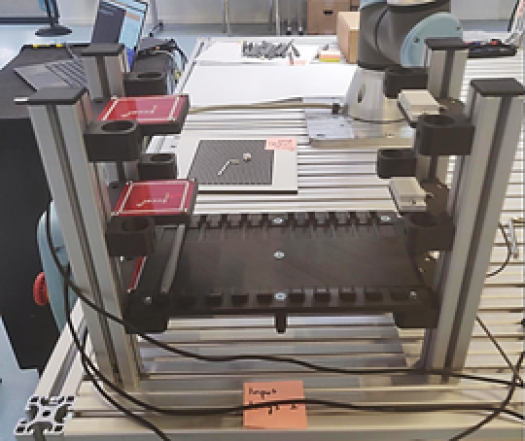What is it?
Optical inspection station is a physical demonstration build of an automated 3D printed part visual inspection cell. Is has automated material handling for part trays and individual parts, camera-based vision system, RFID and serial based part and tray tracking, standard industrial inductive presence sensors, wired cell local LAN and local computational capabilities for control, vision and analytics. While the hardware itself would not surprise anyone familiar with industrial automation environments, the software components are presenting a rather novel approach based on RAMI 4.0 AAS. The main goal of the station is to demonstrate how the AAS architecture could be implemented, what are the benefits, what still needs to be addressed.
Why it is important?
Data driven technologies are seen more and more relevant to the industrial environments with some claiming that it is leading to the 4th industrial revolution. Increasing connectivity and availability of cheap computational power and memory allows to access and process information more easily than before, enabling improvement of the existing processes and creation of new use cases. On another hand, historically installed industrial systems are often not well connected, information is spread around different systems that don’t talk to each other, different communication protocols are used, and no uniform data models were implemented.
This points toward the needs of the standardised architecture that uses available technology to address the issues that current industrial systems face. One of the attempts to create such architecture is RAMI 4.0 (Reference Architectural Model Industry 4.0) and its main component AAS (Asset Administration Shell). RAMI 4.0 approach tries to aggregate and extend existing standards and change how we build, integrate, use, and maintain industrial systems in the future.
Implementation
Physical platform implementation is based on several subsystems:
- Part and tray handling system – that consists of cobot arm and tray shelving
- Part and tray serialisation system – that consists of RFID tag readers and OCR serial number reading software
- Optical inspection system – that consists of lighting, camera, optics, PC and vision application
- DAQ system – that consists of (mostly) presence sensors, digital input/output units and industrial NUC computer
- Station base – that includes table, electrical panel, power supplies, standard button terminal and platform indicators
- Local operator GUI – touch screen monitor with graphical user interface application displayed on it
Integration of each subsystem and subsystem components is done via AAS data models and applications. Each individual inspection station component is represented by its own AAS which provides relevant information about asset as well as the control interface (where applicable). AAS application can communicate to each other via OPC-UA communication protocol.
Conclusions
There are multiple different technologies and architecture emerging as part of Industry 4.0 effort. It is important to understand how these could be applied in the real-world environments as well as what are the limitations and benefits of the different approaches. Optical Inspection Station demonstrator allows to have a glimpse at potential route of AAS implementation, benefits and challenges.
| Country: | IE |
| Address: | Unit A, Aerodrome Business Park, Rathcoole, Co. Dublin D24 WCO4 |





Integration of each subsystem and subsystem components is done via AAS data models and applications. Each individual inspection station component is represented by its own AAS which provides relevant information about asset as well as the control interface (where applicable). AAS application can communicate to each other via OPC-UA communication protocol.
The main goal of the station is to demonstrate how the AAS architecture could be implemented, what are the benefits, what still needs to be addressed.